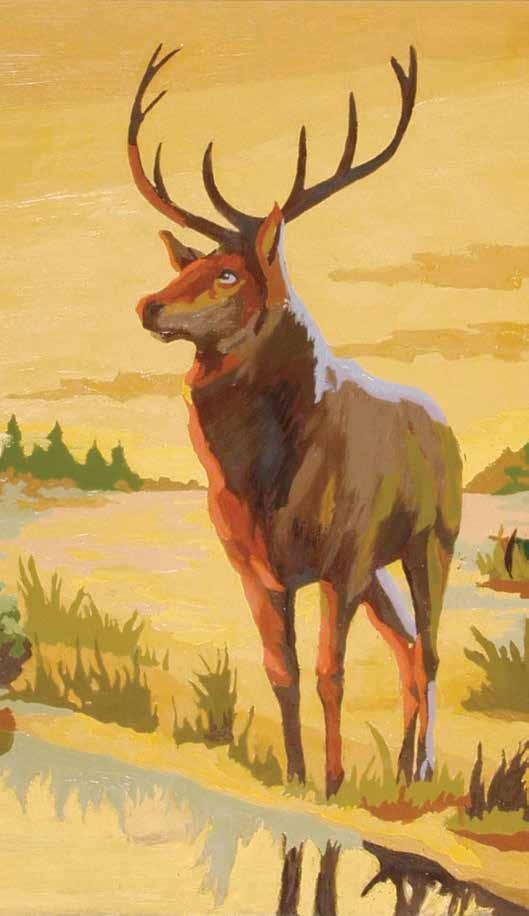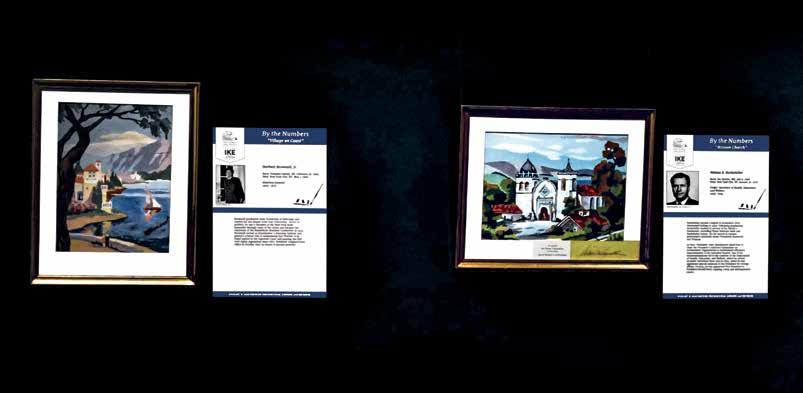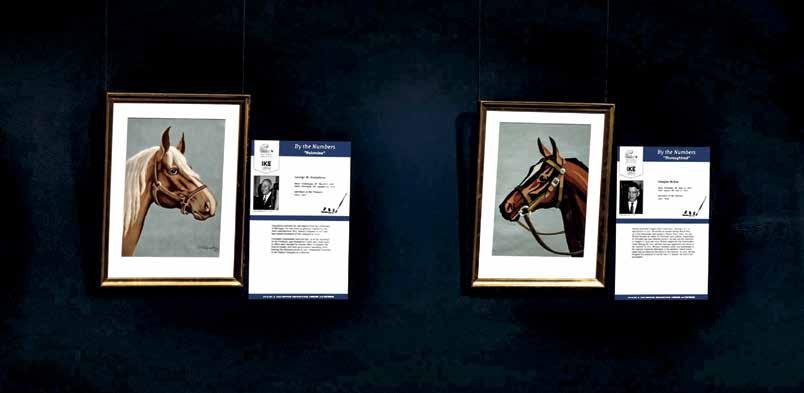Paint-by-Numbers: A CHRISTMAS GIFT to President Dwight D. Eisenhower

49 white house history quarterly
49 OPPOSITE: ALAMY / ABOVE: paintbynumbermuseum.com white house history quarterly
TROY ELKINS, JEFFREY NELSON, AND WILLIAM SNYDER
WHAT TO GIVE A NEW PRESIDENT FOR CHRISTMAS?
as the christmas of 1953 approached, President Dwight D. Eisenhower was concluding his first year in office. His appointment secretary, Thomas Stephens, had begun to worry about how to find the perfect gift for his boss. Perhaps one of Eisenhower’s many hobbies might provide inspiration. Gifts for the popular president had been arriving all year, however, from all over the country. Customized golf balls and golfing accessories as well as fly-fishing rods and hand-tied flies came by the dozens.
The president also enjoyed painting as a way to relax. It was a relatively new hobby, begun during his recent tenure as president of Columbia University, possibly at the urging of his good friend Winston Churchill, also a painter. Perhaps “art” would provide the answer for the gift Stephens was searching for.

and around the West Wing of the White House as a surprise for the president. Although intended for Christmas, the paintings continued to arrive over the next few years, providing a rotating “art” exhibit that often brought smiles to staff and visitors alike.
A 1950 S PHENOMENON
previous spread
Detail of a canvas numbered to correspond to each numbered paint pot included in a paint-by-numbers kit and a c. 1955 advertisement flaunting the simplicity of the process. left
Thomas Stephens (far left) conceived of a plan to have White House officials, cabinet members, and friends complete a collection of paint-by-numbers projects as a gift for President Eisenhower. A painter himself, Eisenhower is seen (above) completing a landscape.
opposite
Stephens, a lawyer and World War II veteran who had been active in Eisenhower’s 1952 presidential campaign, was the first official to see the president each morning and one of the last to see him at the end of each day. The president relied on Stephens’s ability to “diplomatically interrupt” any meeting that ran too long, but his role was much more than keeper of the president’s schedule. An astute political observer, Stephens was also one of Eisenhower’s most important advisers. It was against this background that Stephens came up with his gift idea. He secretly handed out paintby-numbers kits to cabinet members, government leaders, and visitors to the Oval Office, asking them to participate. Then he collected the resulting paintings and created a gallery of them in his office

The post–World War II economic boom, further enhanced by policies of the Eisenhower administration, resulted in a strong and growing middle class. Shorter work weeks and a thriving economy meant that millions of Americans had more leisure time and disposable income. This newfound free time and extra money were often used for new relaxation activities. One of the most popular hobbies of the 1950s was the paint-by-numbers phenomenon.
Dan Robbins, an employee of Palmer Paint in Detroit, Michigan, developed the paint-by-numbers kits as a way to expand sales. He got the idea from a method that Leonardo da Vinci had used to train new apprentices in his studio. Robbins developed kits with a printed and numbered pattern that came with brushes and paints. Sales to the public began in 1951. Six different pictures were available at first, and, as popularity grew, more kits were designed. By 1954 the Palmer Paint Company had sold more than 12 million kits under the Craft Master brand. Soon many other companies were producing similar kits, increasing competition.1
Dan Robbins, an employee of Palmer Paint in Detroit, developed the first paint-by-numbers kits as a way to expand sales and soon sold more than 12 million kits under the Craft Master brand. A selection of the popular kits is seen on display at Woolworth’s Five and Dime, c. 1955.
50
BOTH IMAGES THIS PAGE: DWIGHT D. EISENHOWER PRESIDENTIAL LIBRARY AND MUSEUM white house history quarterly
The paint-by-numbers kits made painting accessible to millions of Americans who would otherwise never have considered taking up painting. The fad was not without controversy, however, with many famous artists of the era deriding the kits as stifling the creative process and wondering if mere painting of numbered canvases could be considered art. In reaction to the critics Robbins said, “I never claim that painting by number is art, but it is the experience of art, and it brings that experience to the individual who would normally not pick up a brush, not dip it in paint.”2 The paint-by-numbers kits made the concept of art approachable in a way that appealed to almost everyone.
THE GIFTS

Although the exact number of kits that Stephens handed out is not known, he definitely covered all his bases with those who visited the Oval Office. Included were his former boss, now Secretary of State John Foster Dulles; special adviser to the president Nelson Rockefeller; Secretary of Health, Education and Welfare Oveta Culp Hobby; one of Ike and Mamie’s favorite band leaders Fred Waring; Governor of Colorado Daniel Thornton; and FBI Director J. Edgar Hoover.

51 white house history quarterly BOTH IMAGES THIS PAGE: GETTY IMAGES




52 ALL PAINTINGS THIS SPREAD: DWIGHT D. EISENHOWER PRESIDENTIAL LIBRARY AND MUSEUM
white house history quarterly
Village on the Coast by Attorney General Herbert Brownell Jr. Herbert Brownell Jr. (above in 1954) practiced law and served in the New York legislature before being appointed attorney general by President Eisenhower.
Palomino by Secretary of the Treasury George Humphrey
George Humphrey (below in 1954) served as Eisenhower’s secretary of the treasury from 1953 until 1957.
Stag at Eve
by Milton Eisenhower, the president’s brother

It is possible that Milton Eisenhower (below in 1954), knowing his brother’s fondness for painting nature scenes often including animals, chose this paint-by-numbers kit from Stephens’ s supply. Milton, the youngest of the seven Eisenhower brothers, was born in Abilene, Kansas, in 1899, the only one of the boys born in the home that now serves as the anchor for the Eisenhower Presidential Library campus. His career included service as president of both Pennsylvania State University and Johns Hopkins University as well as federal appointments and unofficial adviser roles for Presidents Franklin Roosevelt through Lyndon Johnson.

53 ALL PHOTOGRAPHS THIS SPREAD: GETTY IMAGES white house history quarterly
Old Mill by
 Ethel Merman
Ethel Merman
Known as “The Undisputed First Lady of the Musical Comedy Stage,” Ethel Merman (left in 1954) made famous many Broadway standards including “There’s No Business Like Show Business” and “Everything’s Coming Up Roses.” Merman was a lifelong Republican and a good friend of President and Mrs. Eisenhower.

54
The
Broadway Star
white house history quarterly ALL PAINTINGS THIS SPREAD: DWIGHT D. EISENHOWER PRESIDENTIAL LIBRARY AND MUSEUM
Top Secret by National Security Adviser
Robert Cutler
Robert Cutler (above in 1952) was appointed by Eisenhower as his national security adviser, the first in the nation’s history. Although serious by nature, Cutler’s sense of humor shows through with his addition of “Top Secret” to this village scene.

Bulldog

by Ambassador to the United Nations
Henry Cabot Lodge Jr.
Henry Cabot Lodge Jr. (below in 1946) served as Eisenhower’s presidential campaign manager. He was named ambassador to the United Nations in 1953.


55
white house history quarterly MERMAN AND LODGE: GETTY IMAGES / CUTLER: AP IMAGES
In January 2023, a collection of paint-by-numbers paintings given to President Eisenhower by his sta and friends went on display at the Dwight D. Eisenhower Presidential Library and Museum. The museum (left) is part of a complex in Abilene, Kansas, which includes the Eisenhower family home.

In January 2023, a collection of paint-by-numbers paintings given to President Eisenhower by his staff and friends went on display at the Dwight D. Eisenhower Presidential Library and Museum. The museum (left) is part of a complex in Abilene, Kansas, which includes the Eisenhower family home.

56 white house history quarterly
56 white house history quarterly
LEFT: LIBRARY OF CONGRESS / ABOVE AND OPPOSITE: DWIGHT D. EISENHOWER PRESIDENTIAL LIBRARY AND MUSEUM
IKE’S GIFT TO US
President Eisenhower was so touched by Stephens’s idea and by the fact that friends and associates would use their personal time to create gifts for him that, at the end of the administration, he insisted that those paintings remaining in the West Wing be sent to Abilene, Kansas, where the presidential library was under construction and the Eisenhower Museum, originally dedicated as a memorial museum to all World War II veterans, had already been completed. Although Eisenhower never used a paint-by-numbers kit himself, he wanted to make sure that these gifts were preserved and shared.

The Eisenhower Presidential Library is doing just that. The twenty paintings that now form the Thomas Stephens Collection will be on display in the museum’s special exhibits gallery for all of 2023.

notes
1. “Craft Master: The History of Paint by Numbers,” Paint by Number Museum website, www.paintbynumbermuseum.com.
2. Dan Robbins, Whatever Happened to Paint-by-Numbers: A Humorous (Personal) Account of What It Took to Make Anyone an “Artist” (Delavan, Wis.: Possum Hill Press, 1997).
57 white house history quarterly
The selection of paintings in the By the Numbers exhibit pictured above and right includes horses, dogs, a seascape, and Mission Church (second from top left), painted by President Eisenhower’s secretary of health, education and welfare, Nelson Rockefeller, who would later serve as vice president under President Gerald R. Ford.













 Ethel Merman
Ethel Merman








